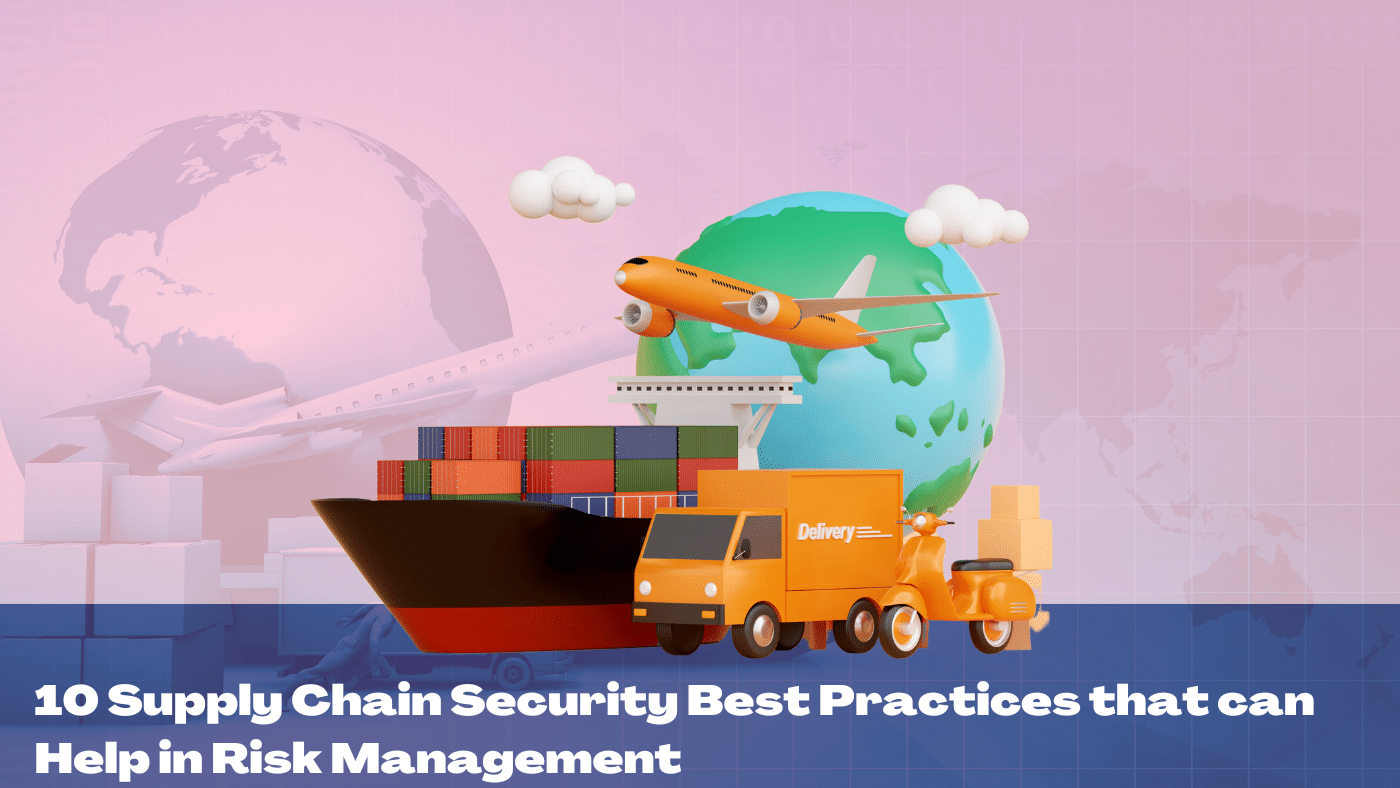Tech Tips
10 Supply Chain Security Best Practices that can Help in Risk Management

Basic statistics play a fundamental role in supply chain security, and as we begin 2024, building resilience in the supply chain remains a top priority. Statistics prove that the value of the supply chain reached $21.95 billion in 2023.
However, the supply chain industry, through research, has also estimated that by 2026 the rate may increase to $30.91. If businesses implement best practices, they will also benefit from them. So, when talking about the best practices to abide by to up the game this year, we can agree that challenges faced in past years have influenced the losses in the supply chain. However, the new emergence of tools and technology plays a major role in the influence of the possible practices that will yield results.
Meanwhile, in this article, we will be exposing you to what a supply chain is and other details you need to know about it in order to up your game.
What are the Basics of Supply Chain?
The basic of supply chain spans the different networks put in place for the success of turning raw materials into a finished product and reaching its potential consumers.
Building resilience around this has to do with incorporating adequate diversification of result-driven strategies, a good inventory management system, and making sure to take advantage of the new emergence of tools and technology for visibility to get across the supply market.
These entities transform raw materials into finished products that meet their target audience.
Before the supply chain networks begin any operation, the audience factor gives them an idea of what they actually want and this information helps essentially in the areas of production development, coming up with the marketing pillars and strategies, the distribution networks, the finance and customer relationship services. The effectiveness of supply chain management gives rise to the profitability of the company’s performance, and if one of these networks or links breaks or fails in strategies, it affects others.
If you’ve been wondering why there’s been a failure in your management, keep reading because you’ll find out the possible potential vulnerability in your supply chain.
In the case of a possible vulnerability in your supply chain, whereby you’re faced with cyber threats and physical threats, it is important to put in place supply chain security.
What is Supply Chain Security
Supply chain security is basically the management body of the supply chain that looks into the possible risks that come with working with an outside organization, or we can say it focuses on how to manage the risks of external suppliers, vendors, logistics and transportation.
Read Also: Top 15 Business Inventory Software to use for your business
Importance of Supply Chain Security
Prioritizing this system is crucial, as certain breaches that can cause damage have the potential to disrupt operations.
- A good management plan in place for supply chain security can help avoid vulnerabilities that will lead to uncontrollable costs, lack of efficiency in delivery, and loss of property.
- Avoid products that can harm customers and your business, as they can tarnish your business reputation and cause you to lose the trust of your potential audience if customers decide to file a lawsuit.
- Security management will ensure the achievement of efficient product delivery.
- A supply chain security management system helps to recover any event disruption.
What are the Possible Potential Vulnerabilities in your Supply Chain?
According to a survey by “The State of Supply Chain Defense Annual Global Insights Reports 2023,” published in December 11 by the supply chain threat monitoring company BlueVoyant, the mean number of supply chain breaches increased to 4.16 incidents in 2023 from 3.29 incidents in 2022.
In 2023, material shortages were the major supply chain issues, and according to KPMG, “71% of global companies highlight raw material costs as their number one supply chain threat.
That means to stand a chance of avoiding a possible vulnerability in your supply chain, first you must identify what it is and possibly how it happens. Although they can occur in both internal and external events, we’ll look at the numerous factors that make the supply chain vulnerable to disruption.
- Fuel prices: when it comes to product delivery, it follows different stages of transportation, and that is to say, a higher cost of fuel can affect the transportation process, which results in delays and forces businesses to go back to their logistics strategy to think of the way forward.
- Natural disaster: this is another vulnerability that also leads to disrupted transportation of products because the occurrence of a natural disaster in any country can lead to road closures and port shutdowns. This causes an increase in transportation costs and delays.
- Cyber-attacks: most times, if you don’t check if your systems are well maintained and are up-to-date, even if they are the latest technology, they are likely prone to malfunction. It can be exposed to viruses, system crashes, hacks, etc. It is important to get a functional IT department that will look into the affairs of this area to avoid certain mishaps from happening which can affect the production process or the business itself.
- Supplier risk is another supply chain vulnerability that can lead to disruption.
- unexpected quality issues.
There are, however, certain supply chain security best practices that can help in risk management.
Supply Chain Security Best Practice
- Inspection of factories and warehouses to avoid unforeseen circumstances
- Tracking shipments
- Adequate performance of security strategy assessments
- Consulting governmental guidelines and regulations (ESG) to ensure the emergence of sustainability
- Auditing the source code of both vendor software and open-source code
- Formulation of a response plan in case threats arise or are discovered
- Using a network level of scanning, behavioral analysis and intrusion detection
- Making sure that authentic data transmission is carried out.
- Background checks are also important.
1. Inspection of factories and warehouses to avoid unforeseen circumstances:
Such inspection can be done to check out the cleanliness of the warehouse space, the safety of the equipment to be used, the safety of inventory storage and tools, electricity, and emergency safety.
2. Tracking shipments:
Some companies have reported to have lost products through lack of tracking shipment or losing track of it along the line. It is crucial to know the location of your products at any time because certain challenges like weather conditions or any unpredictable challenges can occur. In this case, a fleet manager should be able to make adjustments and make sure information is passed across to the waiting audience about the delay, and possibly promise when the products will be available.
3. Adequate performance of security strategy assessments:
To achieve this strategy, you need to follow steps such as generating a complete map of any potential assets, and it is not about the identification of hardware in use; look into all applications and both human and process users. Check out all data storage containers cause each of these contributes greatly to the attack. Log and track each of these assets in a centralized database that can be easily updated, then assign each asset value and map its data flow.
Another step is to analyze and develop security controls, create a remediation plan to resolve any risk, and above all, implement all steps and rinse and repeat the process.
4. Consultancy:
Consulting governmental guidelines and regulations (ESG) to have an emergence of sustainability.
5. Audition of source vendor source code and open-source code:
It is generally recommended that audits should be carried out at least once a year to ensure that the codes are free from any vulnerabilities.
6. Formulation of response plan in case threats arise or are discovered:
Here, you create a policy that guides incident response, create a response team and delegate responsibilities, develop a guide they can use also, and create a communication plan that is transparent to the company and that the audience can understand. Test the plan, take note of what is working and what is not, and then keep updating the process according to the response rate.
7. Using a network level of scanning, behavioral analysis, and intrusion detection :
Network intrusion (IDS) and prevention (IPS) systems attempt to detect any unauthorized access to an enterprise network by analyzing the network traffic to detect any malicious access. This system is usually placed whether at the ingress or egress (entrance or exist) points of the network.
However, the network behavioral analysis detects the malicious behavior using the network traffic statistics that are exported by router switches or network probes.
8. Making sure that authentic data transmission is carried out:
When it comes to data transmission, it is vital to ensure that transmission is gotten from a valid entity and there’s no hitch along the line.
9. Background checks are also important:
It is vital to carry out a background check on the supplier to ensure that they are legitimate and capable of handling any responsibilities.
Conclusion
Overall, the best practice in supply chain management is to take action immediately. It is not advisable to wait until a certain vulnerability occurs before looking for measures to follow. The best practices to help you in your supply chain in 2024 have been highlighted above to avoid mishaps. Remember, once any of these networks of the supply chain has a breach, it ultimately affects other links.

